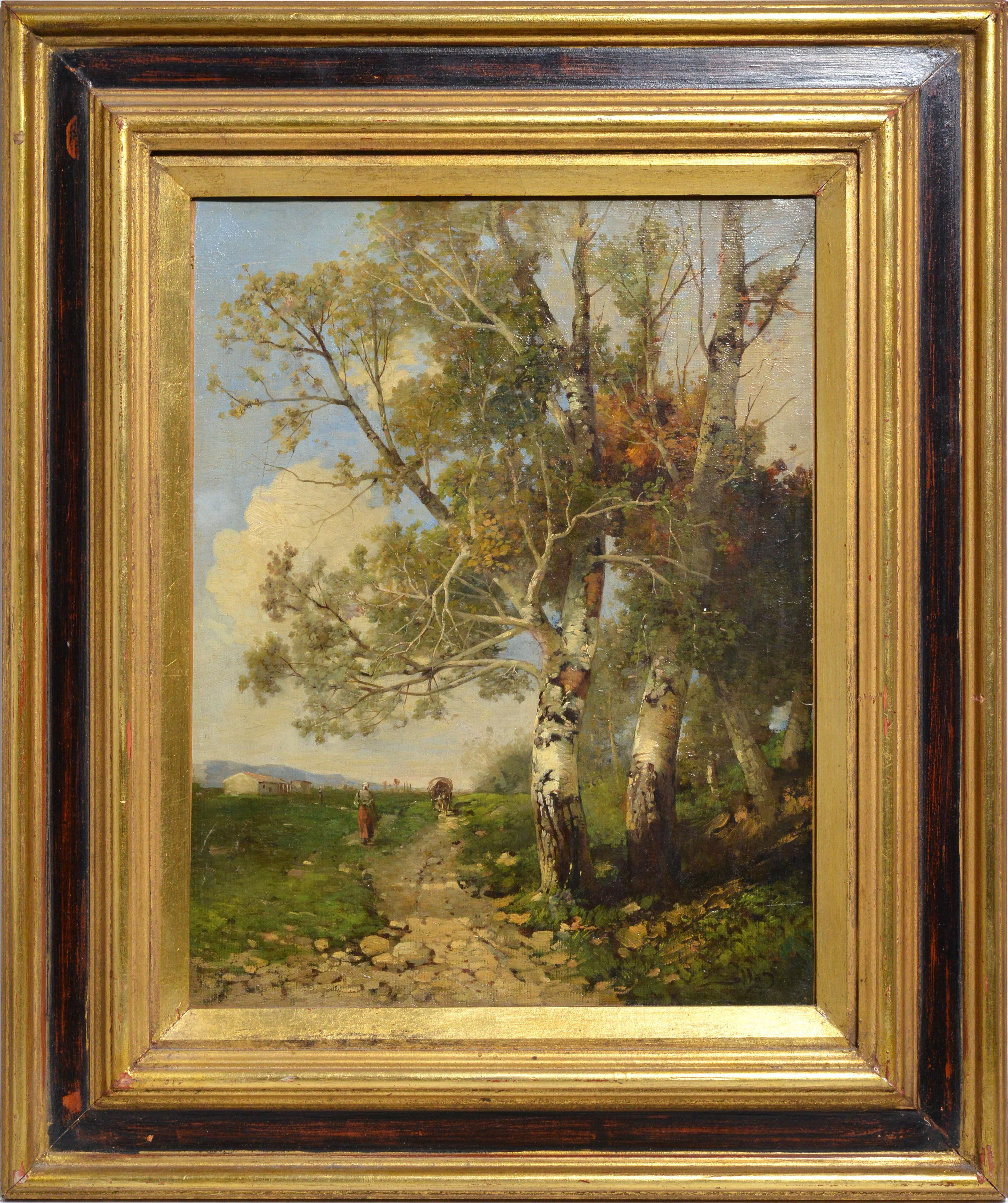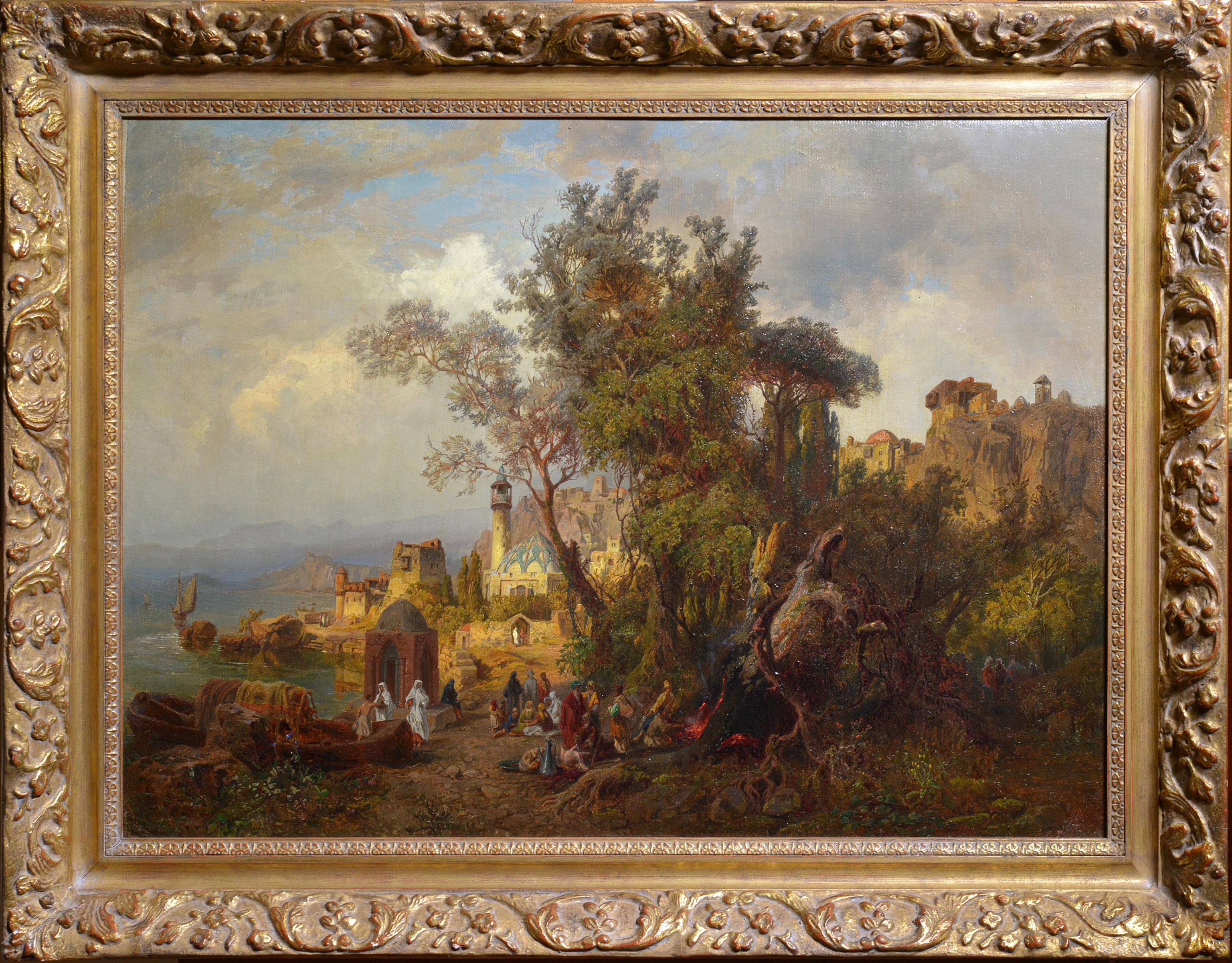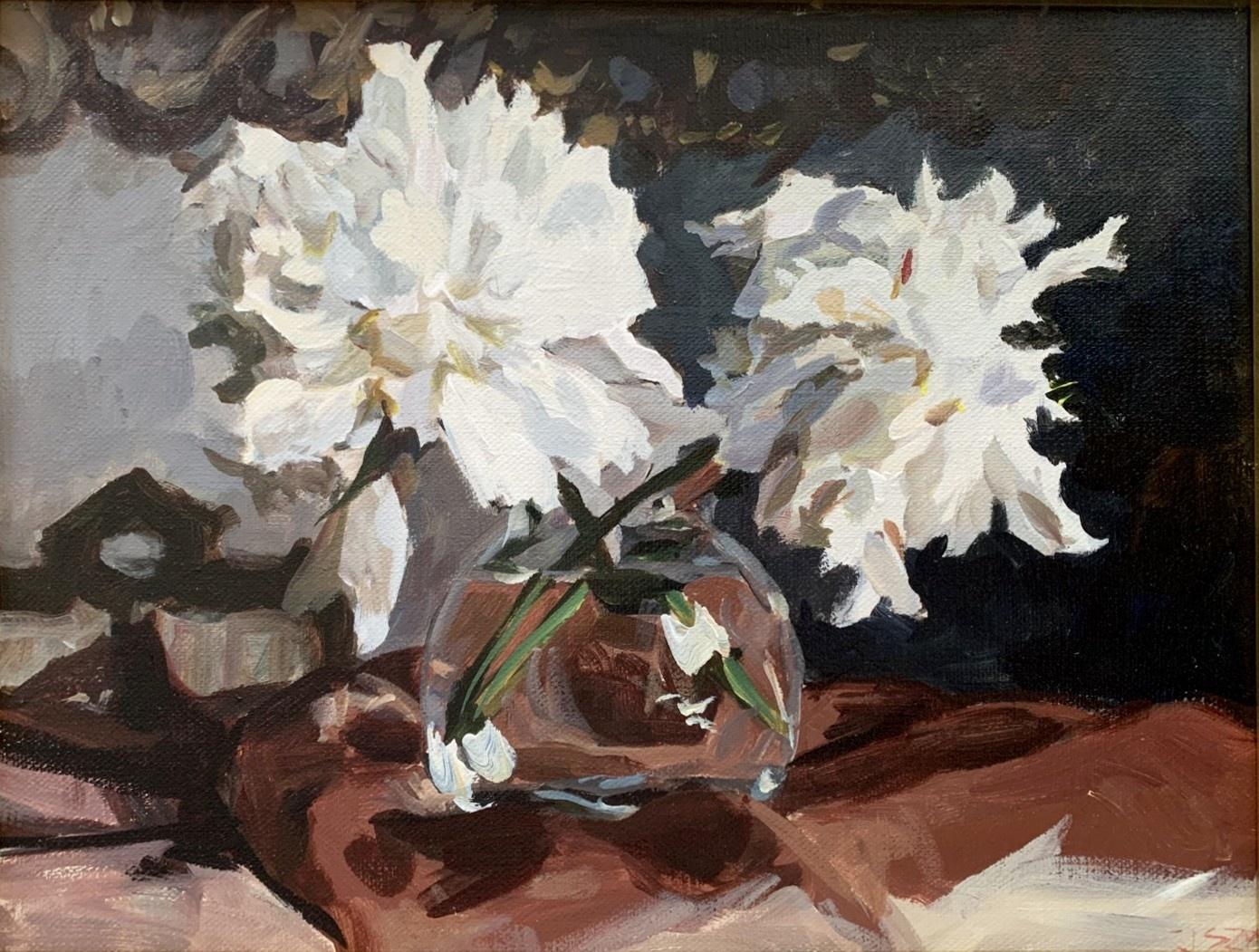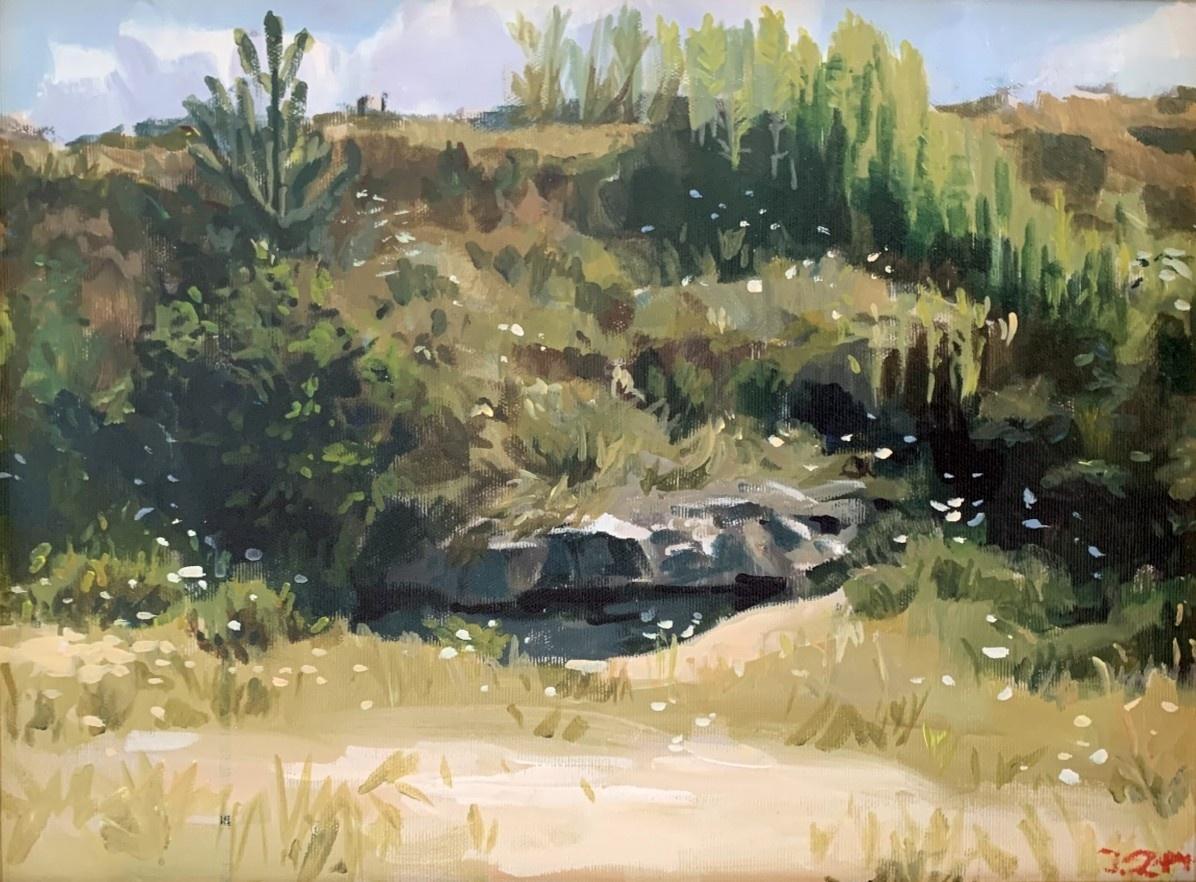Items Similar to "Ca' d' Oro, Venice" Late 19th Century Oil on Canvas of Venice, by Antonio Reyna
Want more images or videos?
Request additional images or videos from the seller
1 of 16
Antonio Reyna Manescau"Ca' d' Oro, Venice" Late 19th Century Oil on Canvas of Venice, by Antonio ReynaCirca 1900
Circa 1900
About the Item
ANTONIO REYNA MANESCAU
Spanish, 1859 - 1937
CA' D' ORO, VENICE
signed & located "A. Reyna, Venezia" (lower right)
oil on canvas
11-1/2 x 19-3/4 inches (29 X 50cm.)
framed: 18-1/4 X 26-1/4 inches (46 X 66.5 cm.)
PROVENANCE
Private Collector, Madrid
In this work Reyna makes a great demonstration of his skill and ability to draw. With a thorough and precise brushstroke he paints this magnificent Venetian Gothic palace.
Its marble traces of the 1st and 2nd floor and the colonnade announces the change of style to the Renaissance. Also the cornice of graceful and delicate forms of local Venetian taste. In the restlessness of the calm waters of the canal, the ocher and golden luminous details of the palace are reflected, framing all the work a soft and liminous light.
Antonio Reyna Manescau (5 December 1859 - 3 February 1937), was a Spanish painter that developed most of his career in Italy. A member of the Málaga School of Painting, he studied under Bernardo Ferrándiz and alongside Moreno Carbonero. He moved to Italy in his early 20's, where he was further influenced by Italian and Spanish expatriate artists, and where he lived for the rest of his life.
After his first visit to Venice in 1885, he specialized in landscape painting. He is widely known for the preciosity of his Venetian vedutas, the importance he places in the accurate depiction of architectural detail and his mastery of color. Among his most important works are his numerous views of the Venetian canals and Piazza San Marco.
Born in the town of Coín (Málaga), he was one of ten children (six of which died in childhood) of Francisco Reyna Zayas (1825-1892) and Matilde Manescau y Otsman (1823-1910). His parents enjoyed a good social standing, being his uncle José Reyna Zayas mayor of Coín while Antonio was a child
Being still a little boy Antonio showed a great ability for drawing. Although he continued living in Coín for the rest of his childhood, he began his artistic training at the School of Fine Arts in Malaga, where he was taught by Joaquín Martínez de la Vega, first, and then by Bernardo Ferrándiz, founder of the Málaga School of Painting. He studied alongside future master José Moreno Carbonero, who was just a year older than him. From a young age he exhibited his works regularly, standing out in the local artistic environment for his use of colors, the attractiveness of his compositions and the agility of his brushwork. In 1880, at age 20, he sold his first important work for the town hall of Coín.
In 1882 he received a scholarship from the Provincial Council to further his art studies in Italy. He moved to Rome (where he was to live until his death), and in 1885 visited Venice; from that year on, Venetian landscapes, showing landmarks like the Grand Canal and Piazza San Marco but also less known quarters of the city, are ubiquitous in his work. Venice was at that time an artistic hub for Spanish painters, thanks in part to Fortuny's widow residing there, and also because of the Venetian production of Villegas Cordero and Martín Rico, whose preciosity in the depiction of the landscape was adopted by Reyna Manescau.
Although his scholarship was supposed to finish in 1886, he was captivated by Italy and remained there. In Rome he frequently visited the workshop of Villegas Cordero, like so many other Spaniards, and under his influence he produced some oriental paintings. At the same time, as a member of the Spanish colony, he was a regular in tertulias in the Café El Greco. In 1889 he married the opera singer Beatriz Mililotti Desantis, then 20, and settled to live in Rome.
Canal in Venice. Museum of Fine Arts, Boston.
Influenced by classical antiquity, by the mid 1880s he painted his lost masterwork Floralia, a classical scene that represents the annual festival celebrated in honor of the mythical goddess
Reyna Manescau's works are represented at museums such as the Boston Museum of Fine Arts, the Hermitage Museum, the Carmen Thyssen Museum and the Málaga Museum, and are also present in various private collections.
- Creator:Antonio Reyna Manescau (1859 - 1937)
- Creation Year:Circa 1900
- Dimensions:Height: 11.42 in (29 cm)Width: 19.69 in (50 cm)
- More Editions & Sizes:29 X 50 cmPrice: $27,509
- Medium:
- Movement & Style:
- Period:
- Condition:
- Gallery Location:Madrid, ES
- Reference Number:1stDibs: LU128115176512
About the Seller
5.0
Vetted Seller
These experienced sellers undergo a comprehensive evaluation by our team of in-house experts.
Established in 1977
1stDibs seller since 2019
21 sales on 1stDibs
Typical response time: 2 hours
- ShippingRetrieving quote...Ships From: Madrid, Spain
- Return PolicyA return for this item may be initiated within 14 days of delivery.
More From This SellerView All
- "Valencian Flower Pickers ", Early 20th Century Oil on Canvas by José MongrellLocated in Madrid, ESJOSÉ MONGRELL Spanish, 1870 - 1937 VALENCIAN FLOWER PICKERS signed “J. Mongrell” lower left oil on canvas 29-1/4 x 45 inches (74 x 114 cm.) framed: 42-3/...Category
1910s Realist Figurative Paintings
MaterialsCanvas, Oil
- "Before the Walls of Jerusalem", 19th Century Oil on Canvas by José VillegasLocated in Madrid, ESJOSÉ VILLEGAS CORDERO Spanish, 1844 - 1921 BEFORE THE WALLS OF JERUSALEM signed "Villegas" (lower left) oil on canvas 12-1/4 x 17-1/4 inches (31.1 x 43.7 cm.) PROVENANCE Private Collector, Seville, Spain José Villegas Cordero (Seville, August 26, 1844-Madrid, November 9, 1921) was a Spanish painter. He directed the Prado Museum between 1901 and 1918. He was the brother of the painter Ricardo Villegas Cordero. He began his apprenticeship very young with José María Romero, with whom he remained for two years until entering the School of Fine Arts in Seville, where he was under the tutelage of Eduardo Cano. In 1860, when he was only 16 years old, he sold his work Little Philosophy for 2,000 reais at the Seville Exhibition. In 1867 he traveled to Madrid, where he entered Federico Madrazo's studio. There he established friendship with painters Eduardo Rosales and Fortuny. He went regularly to the Prado where he copied Velázquez, from whom he acquired spontaneity and the use of color for his technique. Finally, and out of admiration for Fortuny's orientalist painting, he returned to Seville and organized an excursion to Morocco. At the end of 1868 he decided to travel to Rome accompanied by the painters Rafael Peralta and Luis Jiménez Aranda...Category
1880s Realist Figurative Paintings
MaterialsCanvas, Oil
- "Filipino Farm Workers in Horse Carriage" 19th C. Oil on Canvas by F. de la RosaLocated in Madrid, ESFABIAN DE LA ROSA Filipino, 1869 - 1937 FILIPINO FARM WORKERS IN HORSE CARRIAGE signed & dated "F. de la Rosa, 1894" (lower left) oil on canvas 42-3/4 x 2...Category
1890s Realist Figurative Paintings
MaterialsCanvas, Oil
- "Place de la Concorde", 19th Century Oil on Canvas by Artist Joaquín PallarésLocated in Madrid, ESJOAQUÍN PALLARÉS ALLUSTANTE Spanish, 1853 - 1935 PLACE DE LA CONCORDE signed & located "J. PALLARÉS / París." (lower right) oil on canvas 13-1/4 x 18-...Category
1890s Realist Figurative Paintings
MaterialsCanvas, Oil
- "Far Away Thoughts", 19th Century Oil on Canvas by Daniel HernándezLocated in Madrid, ESDANIEL HERNÁNDEZ Peruvian, 1856 - 1932 FAR AWAY THOUGHTS signed "Daniel Hernandez" (lower right) oil on canvas 27-1/2 x 19-1/4 inches (70 x 49 cm.) framed: 39-3/8 x 31-1/8 inches (100 x 79 cm.) Daniel Hernández Morillo...Category
Early 1900s Realist Figurative Paintings
MaterialsOil, Canvas
- "Venetian Canal" Late 19th Century Oil on Canvas by Spanish Artist Antonio ReynaBy Antonio Reyna ManescauLocated in Madrid, ESANTONIO REYNA MANESCAU Spanish, 1859 - 1937 VENETIAN CANAL signed & located "A. Reyna, Venezia" (lower left) oil on canvas 11-1/2 x 19-3/4 inche...Category
1890s Realist Landscape Paintings
MaterialsCanvas, Oil
You May Also Like
- Summer Landscape with Birches by Austrian Master Gollob Early 20th century OilLocated in Stockholm, SEHeinrich Gollob (1886 - 1917) - Austrian painter. Gollob's attention to detail demonstrates his talent for bringing landscapes to life through vibrant colors, textures and the play o...Category
Early 20th Century Realist Landscape Paintings
MaterialsCanvas, Wood, Cotton Canvas, Oil
- Evening on River German Master Caucasian Panoramic Landscape 19th centuryLocated in Stockholm, SEAttributed Paul Von Franken (1818-1884), famous Gemany a genre and landscape painter, signed bottom right. Fertile scenery coastal town with castle, mosque, minaret, large travelers ...Category
1850s Realist Landscape Paintings
MaterialsCanvas, Wood, Oil
- Peonies - Contemporary Still life Oil Painting, Realism, Polish artBy Janusz SzpytLocated in Warsaw, PLJanusz Szpyt was born in 1960, he is a Polish painter. He graduated from the Graphic design faculty and painting from the Academy of Fine Arts in Krakow. ...Category
2010s Realist Landscape Paintings
MaterialsOil, Canvas
- Roztocze - Contemporary Landscape Oil Painting, Realism, Polish artBy Janusz SzpytLocated in Warsaw, PLJanusz Szpyt was born in 1960, he is a Polish painter. He graduated from the Graphic design faculty and painting from the Academy of Fine Arts in Krakow...Category
2010s Realist Landscape Paintings
MaterialsOil, Canvas
- Luis Lopez, Oil on canvas "Beach Near Valencia", fishermenLocated in Saint Amans des cots, FROil on canvas by Luis LOPEZ, 1983, Spain. Beach near Valencia. Fishermen, fisherman. With frame: 106.7x80 cm - 42x31.5 inches ; without frame: 92x65 cm - 36.2x25.5 inches. P30 format...Category
1980s Realist Figurative Paintings
MaterialsCanvas, Oil
- Halmstad Harbour Seen From the North, 1889Located in Stockholm, SEThe painting "Halmstad Harbour Seen From the North" by Oscar Ohlson is a captivating snapshot of daily life and historical architecture, frozen in time from the year 1889. With a meticulous eye for detail, Ohlson has rendered approximately 25 boats in the harbor, each brimming with the quiet bustle of daily chores. The painting invites viewers to step into a moment where people converse, work, and seek respite from the sun under shared umbrellas, while wisps of smoke subtly rise from several boats, suggesting the presence of life and activity beyond the canvas. In this vibrant scene, a man carries a sack, perhaps fresh merchandise from one of the docked vessels, while others engage in conversation, highlighting the social tapestry of the harbor. Ohlson's masterful use of light reflects on the water, creating a shimmering path that leads the eye to the majestic Halmstad Castle, which adorns the right side of the painting. This historic building, beautifully situated by the Nissan river and not far from the sea, is a testament to Halmstad's past as a Danish territory. Constructed in the early 17th century during the reign of King Christian IV, the castle stands as a reminder of the town's rich history and cultural heritage. The first building to the right, once part of this historic tableau, has been removed to accommodate modern necessities, replaced by a road that now runs through its former site. This juxtaposition of past and present is a poignant commentary on the evolution of cities and the sacrifices made in the name of progress. Halmstad itself, a town that straddles the Nissan river, retains much of its early 20th-century character in its city core. Low brick and half-timbered houses, some dating back to the 17th century, dot the landscape. The town center on the west side of Nissan is bordered by remnants of early 17th-century fortifications, including the 1600s castle, Norre Port from 1601, and King Charles XI's path along the old fortress wall. At the heart of the town is Stora Torg with Carl Milles' Europa and the Bull fountain from 1926, and the town hall built in 1938. The city layout, influenced by Renaissance planning, converges at Stora Torg, which is also home to the town's sole medieval building, the brick hall church of St. Nikolai from the 14th century. Oscar Ohlson (1847-1912), a native of Linneryd, Småland, was a multifaceted individual. Beginning his career with a legal degree from Uppsala University in 1870, Ohlson's passion for the arts led him to pursue music studies before dedicating himself to art under the guidance of Alfred Wahlberg...Category
1880s Realist Landscape Paintings
MaterialsCanvas, Oil
Recently Viewed
View AllMore Ways To Browse
Venice Mid Century
Venice Antique
Traces D
Ten Works By Ten Painters
Antique Finish Painting
Italian Late 19th Century Oil
Death In Venice
Venice Painting Mid Century
Landscape Realist 19th Century
Old Masters Venice
19th Century Venice Painting
Venetian Landscape Paintings
Death In Venice Painting
Oil Canvas Italian Landscape 19th
Venice Oil Drawing
Italian Renaissance Landscape
Oil Late 20s
Oil On Canvas Venice Scene



